In all of recorded history, there has never been a matriarchy. Why?
What happens when women are given power?
Quick announcement before we commence with the mind-blowing matriarchy data, next Sunday- January 26th at 11:00am PT will be our Matriarchal Blessing zoom discussion (we will be discussing Riane Eisler’s The Chalice and The Blade) for paid subscribers. If you would like to join us- please do! You can knock out the audiobook in 3 hours. Or just come even if you haven’t read it/finished it. The registration link is below the pay wall at the bottom of this article. See you next Sunday!
“Nearly 60 percent of all college students today are women. That’s an all-time high… U.S. colleges and universities have lost about 1.5 million students in the past several years. Men accounted for 71 percent of that loss.” - Freakanomics Radio
This is how I began an article I wrote a few months ago about male college enrollment dropping.
In the comment section of that article men and women alike fretted that women are starting to “take over.”
After all, women now outnumber men not only in Bachelor’s degrees, but in Master’s and doctorate degrees as well.
If more and more women climb the ranks of leadership, will women start to take over and dominate society?
Think pieces on diminishing masculinity, Senator Josh Hawley and select men on YouTube are all very concerned about this potentiality:
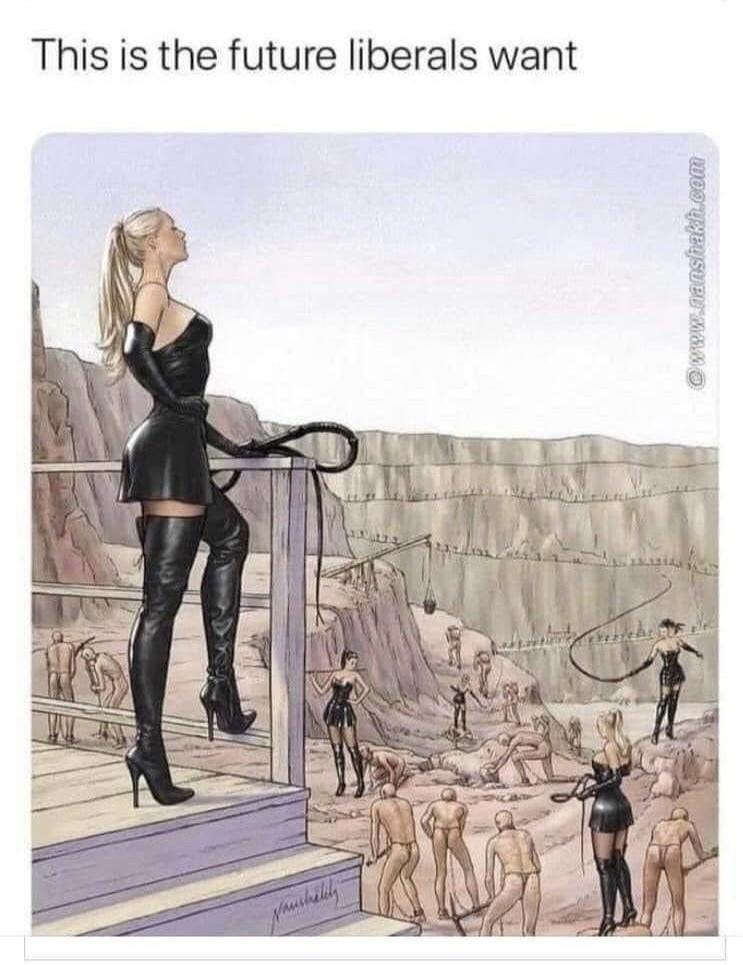
Loathe as I am to put these patriarchs at ease, I will do so on this one topic: Patriarchs, you do not have to worry about women taking over and subjugating men as men have historically subjugated women.
No for real.
You really, really, REALLY don’t.
First off, while it’s true that an increasing number of women have been gaining financial independence since the 1960s, we are so far from women actually taking over, it’s laughable.
Men still firmly dominate leadership across government, business and religion worldwide.
A mere 26 of the 193 countries in the UN are currently led by women, many of those for the first time. Only 10% of Fortune 500 companies have female CEOs. Many of the world’s leading religions (Islam and Catholicism for example) don’t even allow female clergy at any level, let alone the upper echelons of global leadership.
But just for shits and giggles, let’s say women did somehow overcome thousands of years of patriarchal precedent and start leading the world in government, business, religion and family life.
Even if that did happen, men still wouldn’t have to worry that women would start enslaving them like Cat Woman up there.
Why?
In all of recorded history guess how many examples we have of a matriarchy?
Go on guess.
Ok, I spoiled it in the title of this article, but the answer is zero.
There have been women rulers. There have been groups of women in powerful positions. There have been matrilineal societies where ancestry and property is traced through the mother’s line. There have been matrifocal societies where women are the heads of households. There have been matrilocal societies where the husband moves into the wife’s household instead of the wife moving into the husband’s.
Many people call those societies matriarchies, but we have no record of there ever being a matriarchy as defined as the inverse of patriarchy.
Patriarchy = “a political-social system where men dominate over women; endowed with the right to rule in government, business, religion, relationships, marriage and family life.”
Statistically speaking, it is very odd indeed that there has never been a matriarchy.
Women make up half the population. How is it that in thousands and thousands of years across all seven continents, out of the thousands of civilizations that had no contact with one another, not one formed where women ruled over and subjugated men?
Why?
Is it because men are just so good at ruling that they end up on top every time?
Well, first off, they don’t end up on top every time.
Archeology is a relatively recent study. It’s only been in the last 200 years that it was discovered that for millennia of human history, the supreme deity was not male, but female.

Upon discovering troves of female goddess statues, shrines and art from the Neolithic period, scholars concluded that if men didn’t dominate over women, women must have dominated over men.
When that was proven false (more on this in a minute), they concluded that male dominance must have always been the prevailing social structure.
But that’s not true either.
While we don’t have examples of societies where women dominated and subjugated men, we do have examples of egalitarian societies and those give us a big clue into this lack-of-matriarchies phenomenon.
According to historian Riane Eisler who wrote The Chalice and The Blade, we don’t have evidence of matriarchies because in the civilizations where women were in power, women shared power and resources with men. Making those societies egalitarian, not matriarchical.
Those civilizations were characterized by a partnership model of rule instead of a dominator model of rule.
Eisler explains that the dominator model is defined by ranking humans in hierarchies and maintaining those hierarchies by competition, control and domination. The dominator model is characterized by the blade- a symbol of power and violence.
The partnership model is defined by linking rather than ranking. Its benchmarks are equality, cooperation and mutual respect. Partnership is characterized by the chalice- a symbol of nurturing and life-giving collaboration.
And if your gender war jets are starting to rumble, let’s cool those engines right now. Eisler is quick to say that women are not inherently better than men. It’s not that men emerge from the womb pillaging, swash-buckling and guarding their piles of gold while women emerge signing peace treaties and singing kumbaya.
The problem is not biology, but social conditioning and systemic structures that train all of us to assume that 1. Society is supposed to be divided by hierarchy (rich over poor, white over black, first world over third world, etc) and 2. Men are meant to rule over all of these hierarchies (business, religion, government, family).
Patriarchy as a dominator system is not an inevitability because it is ruled by men. It’s a self-fulfilling prophesy with indoctrination in place for both women and men to collude into their assigned patriarchal roles through centuries of domination propaganda.
Here’s how Eisler puts it:
"For millennia men have fought wars and the Blade has been a male symbol. But this does not mean men are inevitably violent and warlike. Throughout recorded history there have been peaceful and nonviolent men. Moreover, obviously there were both men and women in the prehistoric societies where the power to give and nurture, which the Chalice symbolizes, was supreme. The underlying problem is not men as a sex. The root of the problem lies in a social system in which the power of the Blade is idealized--in which both men and women are taught to equate true masculinity with violence and dominance and to see men who do not conform to this idea as too soft or effeminate.”
This is not a man vs woman thing. This is an all of us vs domination thing.
Ok, now that we’ve slowed our gender war tanks, let’s get to the questions of how do we know that women had power in ancient civilizations and how do we know those societies were more equal?
Great questions, thanks for asking.
Because we have lived in a dominator patriarchal system for so long, it is difficult for us to imagine a time when war and women-as-second-class citizens wasn’t the norm. But it wasn’t.
Ancient Matri-centric Societies
1Around 3500 BCE the Kurgans and other warring tribes invaded Europe. Shortly after is the first evidence we have of chieftan burials in Europe where the graves of male leaders included the skeletons of sacrificed women.
This is also when we start seeing spears, knives and bows and arrows being buried with men, and when the art starts depicting wars and battles.
But before this, in the Neolithic period, cave art, sculptures, burial sights and dwellings all point to a partnership model with remarkably little evidence of weapons. The art of this time is overwhelmingly of nature and goddess worship.
Catal Huyuk. 7500 BCE - 5600 BCE
In what is now modern day Turkey, there was once the ancient matrilineal, matrifocal society of Catal Huyuk.
British archeologist James Mellaart has dedicated his career to studying Catal Huyuk. He describes their spirituality in this way, “the divine family of Cattle Huyuk is represented in order of importance as mother, daughter, son, father.”
The women’s sleeping platforms were always found in the same place, on the east side of living quarters, while the men’s platform shifts around. Male partners join the woman’s family, not the other way around, making Catal Huyuk a matrilocal society.

There is also an abundance of evidence of goddess worship in Catal Huyuk.
For these reasons Catal Huyuk is often referred to as a matriarchy, but just because their society worshiped the feminine does not mean they subjugated the masculine (as patriarchy subjugates the feminine).
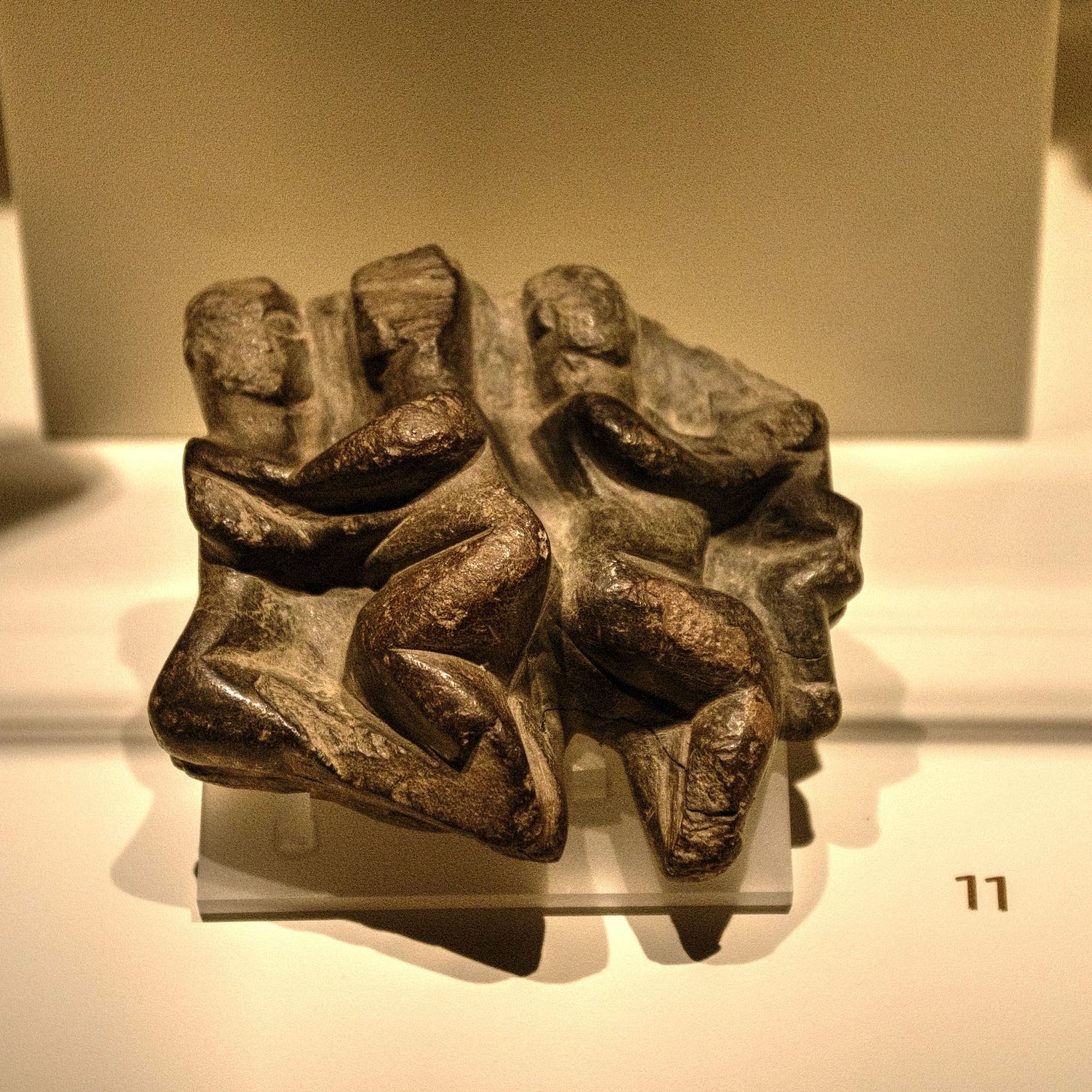
On the contrary Catal Huyuk is defined by its egalitarianism- both spiritually and physically.
Another Catal Huyuk expert, Marija Gimbutas says this of the civilization:
“The world of myth was not polarized into female and male as it was among the Indo-Europeans and many other nomadic and pastoral peoples of the steppes. Both principles were manifest side by side. The male divinity in the shape of a young man or male animal appears to affirm and strengthen the forces of the creative and active female. Neither is subordinate to the other.” - Gimbutas, The Chalice and The Blade
In contrast to later civilizations with vastly different sized houses according to wealth and rank, the houses in Catal Huyuk were all the same size- roughly 25 square meters.

Minoan Crete. 3000 BCE - 1100 BCE
Around 2000 BCE in ancient Greece, the goddess who ruled the Neolithic period was demoted and replaced by violent male gods. But on the island of Crete, the rule of the goddess lingered roughly 900 years longer than rest of Greece.
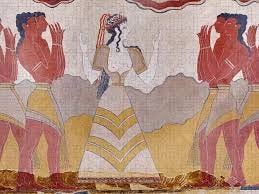
Minoan Crete was also a matrilineal and matrifocal society.
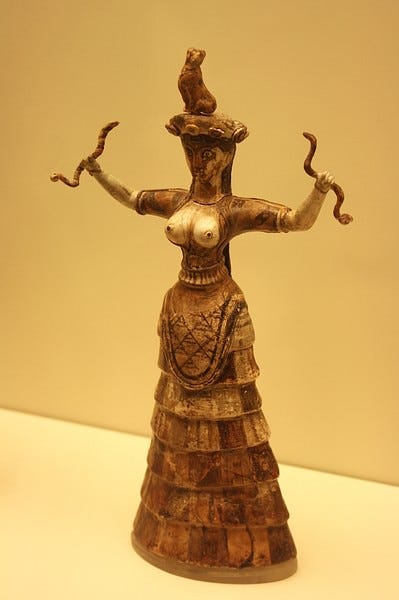
While defenders of a dominator model of society say that we need dominator systems for the advancement of society, ancient Crete shows us this is not true.
In fact, the Minoans are hailed as the first advanced civilization in Europe.
The very first example of a paved road in ancient Europe was in Crete. As well as the first examples of viaducts, large-scale irrigation systems and even indoor plumbing.

While in surrounding civilizations, technology and wealth were reserved for the enjoyment of the powerful few, in Crete government revenues were used to improve living conditions for everyone.
In ancient Sumer, Egypt and Rome, we have many examples of elaborate monuments and shrines built for their emperors, but in ancient Crete, there is no evidence- either in art or architecture- of a royal family, a royal class or a royal elite.
In contrast to their neighbors, battle scenes are also markedly absent from their art. Instead, Minoan shrines, houses, vases and sculptures depicted mostly nature and community.
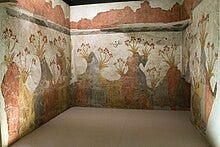
As in Catal Huyuk, Minoans worshipped the goddess, but both her lover and son were also divine. Which stands in stark contrast to the Abrahamic religions- Islam, Christianity and Judaism- that would come to replace divine equity where only Father and not Mother is divine.
Riane Eisler emphasizes that these matrilineal goddess worshipping civilizations were not perfect utopias. They were made up of humans. There was still violence. However “it does indicate that they were not as violent or inequitable as what came later.”
And if you can’t make it to ancient Crete to see the sites yourself, allow Julia here from TikTok2 to enjoyably run you through the epiphanies she had whilst visiting the remains of the ancient civilization “run by chubby women”:
(TikTok is now banned (for today? for forever? who knows) so this video is my downloaded copy of Julia’s TikTok. Follow Julia on Instagram here and YouTube here).
Modern Matri-centric societies
The Minangkabau
Between the years of 1981- 1999, anthropologist Peggy Reeves Sanday lived at least three months of every year in a Minangkabau village called Belubus in West Sumatra. The Minangkabau people are the largest and most stable matrilineal society in the world with over five million people dating back to the third century.

Her findings of this modern-day “matriarchy” align exactly with Riane Eisler’s research findings of ancient “matriarchies”- that when women lead, they follow a partnership rather than a dominator model of governance.
“The Minangkabau are known in Indonesia for their literary flair, business acumen, and egalitarian, democratic relationships between men and women.” - Peggy Reeves Sanday, Women at The Center: Life in a Modern Matriarchy
While the houses and farmlands are owned and run by maternal clans, Sanday found that decisions are made by consensus with the communal good in mind.
“Neither sex rules, it was explained to me, because males and females compliment each other.” - Peggy Reeves Sanday
The Mosou
When National Geographic journalist Liu Kankan stayed in the village of Lijiazui among the Mosou people of Southwest China, she found the men to be quite content to be living in a what is known as “The Kingdom of Women” even though their way of life differed dramatically from that of the men in neighboring societies.
One interviewee described their living conditions in this way:
“Unlike Han marriages,” she said, referring to China’s majority ethnic group, “couples here don’t live together in a 24-hour-a-day, 7-days-a-week kind of married life. Husbands stay at their own villages and take care of their own immediate families during the day and come back in the evenings to their wives’ villages, where they stay with their wives’ families. They depart again the next morning back to their villages. We bring up the kids equally.” - Yang Da Wa Zhuoma

It is estimated that there are roughly 160 matri-central societies still in existence. Anthropologists continually find that these societies follow the pattern found in the ancient matri-central societies- namely that they are characterized by egalitarianism.
But what happens when women are in power in a patriarchal society?
Sometimes as I write my little essays, a little parade of nay-sayers march through my head disagreeing with me. This procession is saying, “Things aren’t better or more peaceful when women rule! My female boss SUCKS!” and cue examples of domineering women in charge who make the world worse.
To that I say- of course not every single woman in the world would rule equitably. Just as not every man would rule dominantly.
Bearing in mind that we have been living in a patriarchal society for thousands of years, men and women alike have the resultant conditioning of thousands of years of patriarchal values like individual success, wealth accumulation, productivity, and efficiency.
Some studies have found that female leaders compensate for the stereotype that women leaders are weak and incompetent by acting with more aggression.
Even so.
Overwhelmingly the examples we do have of what happens when women are given power in countries and corporations are not at all negative. Quite the opposite.
This report from the Westminster Foundation for Democracy found that female-led countries have faired better in tackling COVID-19 and at counteracting corruption, are less likely to go to war, less likely to commit human rights abuse, have better represented their constituencies and even strengthened their economy.
This study of 22 countries found that an increase in women’s legislative representation led to a decrease in conflict behavior and defense spending.
Nick Kristof has been a Pulitzer Prize finalist seven times3 for his coverage of the genocide in Dafur, The Tiananmen Square protests, the Iraq war, human trafficking rings and other many human rights abuses the world over the past 40 years.

In the book Half the Sky he, along with his wife Sheryl WuDunn, argues that the quickest and best way to combat global poverty, war and inequality?
Is to educate and empower women:
“In general, the best clue to a nation's growth and development potential is the status and role of women.”
“Women's empowerment helps raise economic productivity and reduce infant mortality. It contributes to improved health and nutrition. It increases the chances of education for the next generation.”
“When women gain a voice in society, there's evidence of less violence.”
“When women gain control over spending, less family money is devoted to instant gratification and more for education and starting small businesses.”
“It's no accident that the countries that have enjoyed an economic take off have been those that educated girls"
“You educate a boy, and you're educating an individual. You educate a girl, and you're educating a village.” - Nicholas Kristof and Sheryl WuDunn, Half the Sky
After 30 years devoted to world-wide human rights as the co-founder of the third largest charitable foundation in the world, Melinda Gates has come to the same conclusion as Kristof.
The Gates Foundation has dipped into just about every type of charitable cause—agriculture, family planning, water sanitation, business loans, infrastructure and disease treatment and prevention.
Guess what she has found is the golden ticket to making humanitarian causes most effective in a country?
Empowering women:
“No country in the last fifty years has emerged from poverty without expanding access to contraceptives.”
“If you want to lift up humanity, empower women. It is the most comprehensive, pervasive, high-leverage investment you can make in human beings.”
“As women gain rights, families flourish, and so do societies…. Women's rights and society's health and wealth rise together.”- Melinda Gates, The Moment of Lift
And while women in power is correlated with a more stable, equitable society, the inverse is also true- the more a society disempowers women, the more likely that society is to be led by an unjust, authoritarian regime plagued by inequality and unrest.
We know men like Andrew Tate and Jordan Peterson believe it is men not women who should be running society, but who else feared women’s empowerment?
“Early twentieth-century dictators like Joseph Stalin, Adolf Hitler, and Benito Mussolini similarly believed home is a woman’s supposedly ‘natural’ and ‘biological’ domain. Stalin’s sexism was more covert, veiled by Soviet rhetoric of equality, yet clearly embedded in the policy changes he championed, such as the restrictive 1936 Family Law. Mussolini, however, made no attempt to disguise his views: he openly claimed that ‘women never created anything’ and should ‘never be taken seriously.’” - Who is Really Afraid of Empowered Women?
In conclusion: You really don’t have to worry about women taking over
When our most prestigious male poets, prophets and philosophers dream up a utopia, what do they describe?
The word utopia comes from a book by Thomas More in 1516 called “Utopia” that describes an island society with communal property, religious tolerance and an equal sharing of resources.
According to Plato there was once a great, noble civilization where all citizens joined in the city’s bounty- the lost city of Atlantis.
According to the Abrahamic texts, the garden of Eden is a place where man and woman lived peacefully together communing with nature.
When our celebrated men describe utopia, they describe places characterized by community and equality- where we share instead of fight, eat together instead of kill each other.
While they aren’t fictional, matri-centric societies also happen to be defined as places characterized by community and equality instead of domination.
What a coincidence.
In “The End of Atlantis: New Light on an Old Legend” John V Luce writes, “The elements of Plato’s Atlantis are a startlingly accurate sketch of the Minoan Empire in the 16th Century BCE.”
Speaking of the garden of Eden Riane Eisler writes, “Once upon a time man and woman lived together in harmony with nature until a male god decreed that woman be henceforth subservient to man” at which point Eden ended.
Kind of makes you wonder why we are so afraid of empowering women.
“The goal is not the rise of women and the fall of man. It is the rise of both women and men from a struggle for dominance to a state of partnership.
If the goal is partnership between women and men, why put so much emphasis on women’s empowerment and women’s groups?….
“Because when you lift up women, you lift up humanity.” - Melinda Gates
Come discuss everything matriarchy with us next Sunday, Jan 26 at 11:00am PT where we will dissect and discuss The Chalice and The Blade together!
The registration link is below this pay wall. Update your subscription to register and join the discussion. Hope to see you there!



